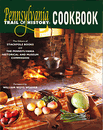Dining on the Railroad
This article originally appeared in Pennsylvania Trail of History Cookbook
When the first passenger train pulled out of Charleston, South Carolina, in 1830, an immediate problem was created: how to feed travelers en route. American enterprise initially filled the need in a haphazard way. When trains pulled into towns, vendors would offer food - chicken, hard-boiled eggs, hams, pies, cakes, custards, coffee, fresh fruit from local orchards, peanuts, soft drinks, and even ice cream - to passengers leaning out train windows, or the vendors would board the train until it departed. The scene at the train station was chaotic, and the food ranged from bad tasting to rancid. Some passengers packed baskets of food, but the result was sometimes equally bad. As one reporter wrote, "The bouquet from those lunches hung around the car all day and the flies wired ahead for their friends to meet them at each station."
The railroad owners soon realized they could earn additional revenue by building or licensing restaurants along the train routes. But even this improvement was problematic for passengers, who might have no more than twenty or thirty minutes at a station to eat and get back on the train. Pandemonium ensued as crowds rushed from the train, jostled each other to get served, then rushed back to the train before it departed. And often the train schedule necessitated inconvenient meal times. Passengers often labeled the eating house an "indigestion house."
The key seemed to be feeding the passengers on the train, which was convenient for the passengers and more profitable for the railroads. The first dining car, a remodeled day coach, appeared on the Philadelphia, Wilmington, and Baltimore Railroad in 1862. Soon competitive pressure forced other railroads to add dining cars. The appeal of the separate dining car was further enhanced when the Pennsylvania Railroad (PRR) in 1887 became the first to offer a vestibule, a flexible covered connection that allowed passengers to move safely and comfortably between cars.
By 1927, the dining car had become a routine part of passenger rail service. The Pennsylvania Railroad Dining Car School was opened that year to teach "deft and courteous service." as well as the proper preparation of meat, soup stock, salads, relishes, breads, desserts, and beverages. The PRR Dining Car Department put out a 109-page booklet of cooking instructions for the preparation of dishes served in the railroad's dining cars. It was not unusual for the well-designed kitchens in the dining cars to serve 300 or more meals a day. By 1938, the PRR was serving 3,000,000 meals a year in its dining cars, with patrons annually consuming 2,500,000 eggs, 550,000 pounds of fowl, 390,999 pounds of beef, 490,000 pounds of pork products, 300,000 pounds of fish, 1,000,000 pounds of potatoes, 350,000 heads of lettuce, 1,300,000 oranges, and 2,000,000 cups of coffee.
Perhaps the most memorable aspects of a dining-car meal were the impeccable service and the ambience, with neat linen tablecloths and napkins, patterned china, silver place settings, and stylish tables and chairs. Passengers could take in the scenery while enjoying a sumptuous meal served by courteous waiters and prepared by skilled chefs in a dining car with the atmosphere of a five-star hotel. A typical dinner menu on the PRR might have included Pennsylvania Dutch chicken, baked potato Pennsylvania *, corn and green pepper saute, cream of chicken soup, Roquefort cheese, deviled slice of roast beef with mustard sauce, ginger muffins, melon mint cocktail, baked Indian pudding *, Pennepicure pie (a rich raisin custard pie topped with meringue), salad with Pennsylvania dressing, stuffed celery, and veal cutlets in paprika sauce.
By 1949,170 dining cars were in operation on the PRR alone, serving more than 4,400,000 meals. Railroad travel declined after World War II, however, and though the PRR invested more than $4,000,000 in coffee shop lounge cars and modernizing the dining cars, the golden age of railroad dining was fast disappearing.
At the Railroad Museum of Pennsylvania in Strasburg, Lancaster County, you can see original dining cars and learn more about the state's rich railroad heritage.
* Recipes for these dishes are available in the Pennsylvania Trail of History Cookbook
Visit
Railroad Museum of Pennsylvania, Strasburg, PA
Explore more than 100 historic locomotives and vintage railroad cars.
For Further Reading
 |
Pennsylvania Trail of History Cookbook Edited by Kyle R. Weaver, Diane B. Reed, and Fred Lauver Forward by William Woys Weaver Stackpole Books and Pennsylvania Historical and Museum Commission 2004 |
 |
Railroad Museum of Pennsylvania: Pennsylvania Trail of History Guide by Dan Cupper Stackpole Books and Pennsylvania Historical and Museum Commission 2002 |




